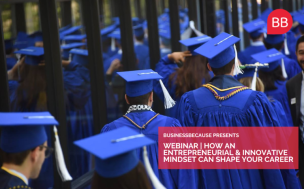“If you are not telling your story on social media, you find yourself left out of an important conversation. Not to mention that your competitors are probably doing it,” said Gwen, who runs Sustainable Brasil Consulting, a consulting firm based in Brazil.
She started the company in November last year after graduating from IE Business School’s MBA program. Today, her business uses social media platforms to market her brand, and she writes a blog about sustainability issues.
“When my company was up and running , posting links to my website and to articles that I had published on LinkedIn and Twitter helped with the marketing,” she said. “The tweets gave visibility to the blog, and positioned me as knowledgeable about sustainability in Brazil.”
Gwen met her business partner at IE and operates the company from Rio de Janeiro. She helped set-up the school's Social Responsibility Forum, which connects MBA entrepreneurs and professionals interested in sustainability.
“I think the ratio should be roughly spending 80% of your time doing great work and 20% of your time communicating about it. The challenge is to use social media enough to be heard, but not so much that you waste time and energy on it,” said Gwen.
The business, which also sets-up initiatives to promote female leadership, is hoping to capitalize on the football World Cup boom in a few weeks’ time. Gwen used her blog to build a community and gain credibility among clients.
Blogs, viral videos and picture promotion are becoming more common forms of social media marketing among the world’s fledgling businesses.
Competition is fierce – especially among firms that have no physical presence – to make their voices herd in the cyberworld. From LinkedIn to Pinterest to Instagram, MBA entrepreneurs are learning how to target users with new social media platforms.
The question is whether start-ups are prepared to diversify from Facebook and Twitter – the staple free marketing tools – and master the newest players.
Lubica Strakova, who runs the Innovation for Growth program at Lancaster University Management School, agrees that social media has grown in significance for businesses over the past five years.
“Social media platforms such as Twitter, Facebook, YouTube, Pinterest and LinkedIn, have huge numbers of users and have become essential cost-effective tools to help boost businesses’ marketing… activities,” said Lubica, who will host a social media workshop tomorrow for SMEs.
But different platforms engage users in different ways. It can be difficult for start-ups to find the best tool for their product or service. Pinterest is best for creating aspirational values – particularly for interior design or very visual companies, said Linda Cheung, CEO of CubeSocial.
“Facebook is much more so the consumer level [platform], and LinkedIn is the most critical one first to sort [out] – it’s your virtual shop front,” said Linda, who set-up the company, which provides social media solutions, in 2011.
CubeSocial works with a bevy of leading law and accounting firms, among others. Linda has owned several start-up services companies, and is a renowned speaker on the topic of social media for business.
“LinkedIn may not be the coolest, but it’s the most important from a professional perspective,” she said. “Linkedin is the most dominant professional social media network – they’re starting to hint towards their 300 million [users] mark,” added Linda.
According to Kirsten Brito, it may even be bad for business to have a social media platform that your users don’t engage with.
The business she set-up in 2012 sells traditional kids’ toys. The Running Rabbits is based in the Philippines but Kirsten is studying a full-time MBA at AGSM in Australia. She has a background in PR – which helps her use social media effectively.
“If your target market does not use Facebook or is even opposed to it, then it may not be a good idea to have one; it may send the wrong message,” she said. “It isn't enough to just have one because every other business has it,” Kirsten added.
Linda thinks that hashtags on Twitter are important, but can be too generic. “Hashtags can be incredibly powerful and efficient ways for finding conversations and contacts,” she said. They also offer a way to communicate without lengthy email chains – but only if you develop a unique phrase.
“For a business, think about how you can make it your own and what a difference that makes. All the noise disappears and it becomes only us,” Linda added.
Kirsten uses hashtags to promote events. “Hashtags are a great way of quantifying and mapping your event following,” she said. But you cannot just expect people to use it. “You can place this hashtag in invitations and any social media posts about the event. This prevents your followers from making up their own multiple hashtags, which doesn't really help you.”
Some tech companies believe social media is essential to connect with users, many of whom are never met face-to-face. Diana Kattan, marketing director of mobile app start-up Slidejoy, said: “Many app developers focus solely on building their apps and fail to connect with users. This, for us, is a big faux pas. How would you know if your users don’t understand a product feature… if you’re not in constant communication with them?”
The business, launched this year, was founded by three Wharton School MBA graduates. They display ads on users’ mobile phones and take a cut of the advertising revenue. In three months Slidejoy was downloaded more than 20,000 times and delivered more than 26 million ad impressions. Their clients include Groupon, Macy’s and Best Buy.
“We’ve been taken aback by our users’ happy remarks [about] our team’s responsiveness and willingness to connect,” said Diana. “This has, in turn, helped our app store ratings, and generated good will.”
The company just joined Instagram, Pinterest and Google+. Slidejoy engages with users by running social media raffles based on the app’s mechanics.
“We’re also using social media to provide additional value to our followers by posting occasional giveaways and special promotions, as well as funny and inspirational content,” said Diana.
The founders didn’t get taught social media marketing at business school. But they learned how to develop a strategy based on consumers’ needs.
“It [an MBA] also taught us how to frame our messages to consumers so as to generate support for our company,” added Diana. “So far, this has been very helpful.”
RECAPTHA :
0a
a3
cb
e4




 2
2 



Comments.